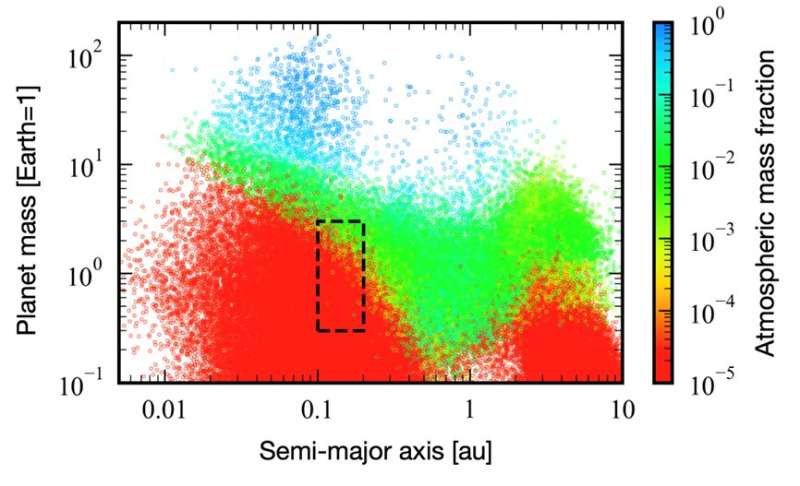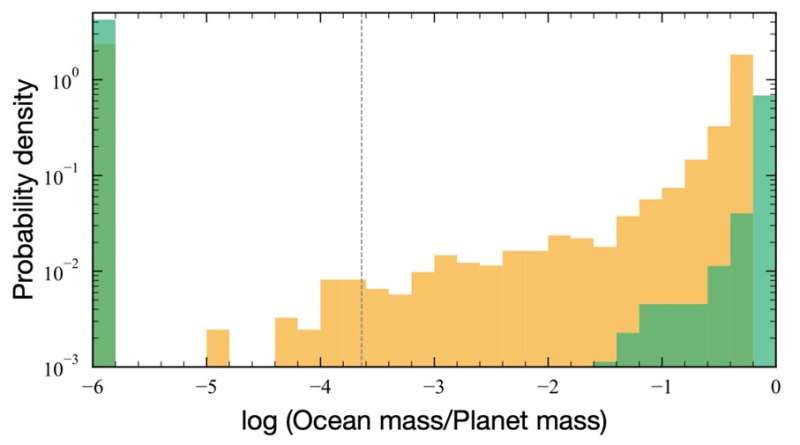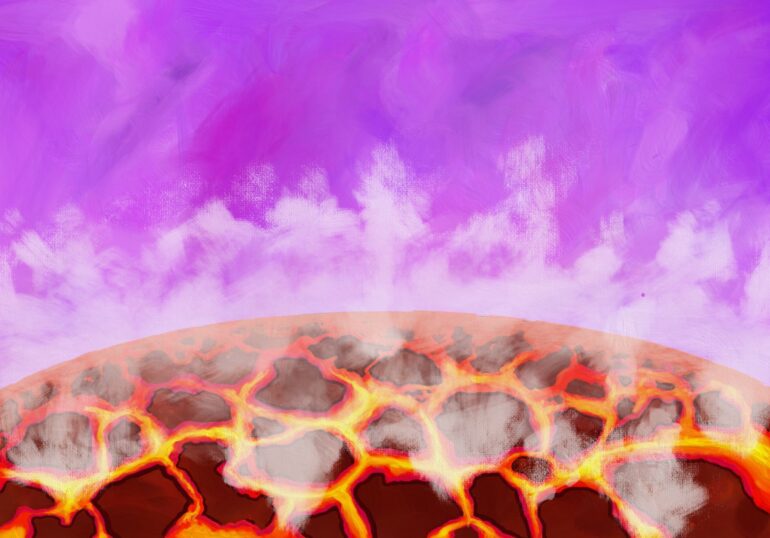Recent exoplanet exploration has focused on the discovery of temperate rocky planets like the Earth, which are often called habitable planets. Most of the recent missions are targeting stars cooler than the sun. Such stars are known as red dwarfs or M-type stars, which are numerous in the solar neighborhood.
Moderate insolation and an adequate amount of seawater are necessary for a planet to maintain a temperate climate. Previous planet formation models, however, predict that the occurrence rate of planets satisfying such conditions around M-type stars is small. New simulations conducted by Tadahiro Kimura, a doctoral student from the University of Tokyo and Prof. Masahiro Ikoma from the Division of Science, NAOJ, have focused on the formation of a hydrogen-rich atmosphere from the protoplanetary disk and water production via the reaction between the atmosphere and the magma ocean.
They have developed a new planet formation model and, thereby, have predicted the amounts of seawater that exoplanets orbiting M-type stars would have. As a result, their estimate shows that several percent of planets with Earth-like radii and insolation orbiting M-type stars have moderate amounts of seawater. This suggests that the discovery of planets with temperate climates in the next decade is likely. The research results have been published in Nature Astronomy on Sept. 29.
Since the first detection in 1995, more than 5,000 planets orbiting stars other than the sun (exoplanets) have been detected. The detection of such a large number of exoplanets has shown that planetary systems exist commonly in the universe. On the other hand, it has also become clear that exoplanets are diverse in terms of size, composition, distance from the central star and insolation.
Among the planets detected so far, there are many Earth-sized planets. Whether any of them have a temperate climate like the Earth is a matter of great interest. Water is necessary for life on Earth, but water also plays an important role in climate. It is known that the maintenance of temperate climates requires a moderate amount of stellar radiation as well as an ocean with a moderate amount of water.
The present-day Earth is able to maintain a warm climate due to the functioning of the carbon cycle with plate tectonics and continental weathering; if the amount of oceanic water were several dozen times greater than on Earth, the carbon cycle would be restricted, resulting in an extremely hot or cold climate.
A widespread idea is that the present-day Earth’s oceans were delivered by water-bearing rocky or icy bodies. Previous studies applying this idea to exoplanets around M-type stars led to the prediction that planets with moderate water content are rare, suggesting that although M-type stars are the main target of future habitable planet searches, habitable planets are highly unlikely to be found.
On the other hand, the production of water in an accumulating atmosphere was proposed as an alternative water acquisition process in previous research by Prof. Ikoma and his colleague. Generally, as a planet grows in a protoplanetary disk, it gravitationally acquires gas from the disk and forms an atmosphere composed mainly of hydrogen.
In addition, the rocky surface of the growing planet is thought to be molten due to the heat of celestial impacts (see Fig. 1); namely, the planet is covered with a magma ocean. At this time, a chemical reaction between atmospheric hydrogen and oxides in the magma ocean lead to producing water. Taking into account the effects of such a water-producing reaction, it is possible to form a planet richer in water than in conventional theoretical models.

Figure 2: Distribution of orbital radii and masses of planets formed around 10,000 M-type stars (0.3 solar masses). The colour of each symbol represents the mass fraction of the planet’s primordial atmosphere. The dashed boxes indicate regions of near-Earth-mass planets in the habitable zone. © National Astronomical Observatory of Japan
The amount of hydrous rock acquired by a planet and the amount of water obtained from water-producing reactions are highly dependent on the planet formation process. In this study, Tadahiro Kimura and Masahiro Ikoma have developed a new planetary population synthesis model to re-estimate the frequency of aqua planets in extrasolar systems around M-type stars.
The model follows the mass growth and orbital evolution of planets based on the latest planet formation theories, and can calculate the amount of water acquired in the process. In addition to the previously considered acquisition of hydrous rocks, the model also newly incorporates the effect of water production in the primordial atmosphere.
Numerical simulations using this model show that a wide variety of planets of different sizes and atmospheric masses are produced in various locations (see Fig. 2). The calculated water content for planets in the habitable zone is shown in Fig. 3.

Figure 3: Probability distribution of seawater mass fractions for planets of Earth-like mass (0.3-3 times Earth mass) located in the habitable zone around M-type stars (0.3 solar masses). Green is the result of calculations following the conventional model and considering only the acquisition of water-bearing rocks. Orange is the result when the model of the present study is used and the effect of water production in the primordial atmosphere is taken into account. The dotted line is the present-day seawater amount on the Earth. © National Astronomical Observatory of Japan
As shown in the figure, exoplanets orbiting M-type stars can retain very diverse amounts of water when water production in the primordial atmosphere works. Some of these planets have formed with similar amounts of seawater to that of the Earth. Most of the seawater on these planets is brought through the atmospheric water production. Analysis of the computational data has led to the prediction that several percent of planets with planetary radii between 0.7 and 1.3 times that of the Earth retain adequate amounts of water to sustain temperate climates (around 0.1–100 times the Earth’s seawater content).
It is expected that nearly 100 Earth-sized planets will be detected in the habitable zone around M-type stars in ongoing and future exoplanet exploration programs such as TESS and PLATO. The results of this study predict that several of these planets will be aqua planets with Earth-like warm climates.
Observations of the atmospheric spectra of exoplanets by the infrared space telescopes JWST and Ariel will also reveal the presence of water molecules and other elements in the atmosphere. These observations are expected to validate the theoretical predictions of this research and lead to a better understanding of the formation process of aqua planets such as the Earth.
More information:
Tadahiro Kimura et al, Predicted diversity in water content of terrestrial exoplanets orbiting M dwarfs, Nature Astronomy (2022). DOI: 10.1038/s41550-022-01781-1
Provided by
National Astronomical Observatory of Japan
Citation:
New theory predicts Earth-like, watery planets exist around red dwarfs (2022, September 30)



